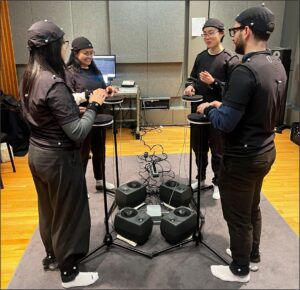In a talk titled “Group Dynamics of Polyrhythmic Coordination in Quartets”, Dr. Bavo Van Kerrebroeck shared experimental results exploring how rhythmic complexity influences synchronization in small musical ensembles.
The study examined how 32 musically trained participants across 8 quartets coordinated while drumming under varying rhythmic demands. Each quartet performed either simple unison rhythms or complex polyrhythmic rhythms, with unpredictable perturbation cues prompting sudden switches between binary and ternary meters.
Key findings included:
- Human quartets showed distinct coordination patterns when switching between rhythmic meters, with transitions to Ternary rhythms proving easier than to Binary ones.
- Hysteresis effects emerged, as participants lingered longer in Ternary patterns after switching.
- Group synchrony showed a delayed drop in polyrhythmic contexts, suggesting increased system stability under rhythmic diversity.
- Spontaneous role differentiation occurred: players switching to Binary meters tended to lag, while those switching to Ternary led.
These results suggest that rhythmic diversity within ensembles may enhance local coordination, while global synchrony is maintained—a dynamic likely relevant to a wide range of group activities beyond music.


